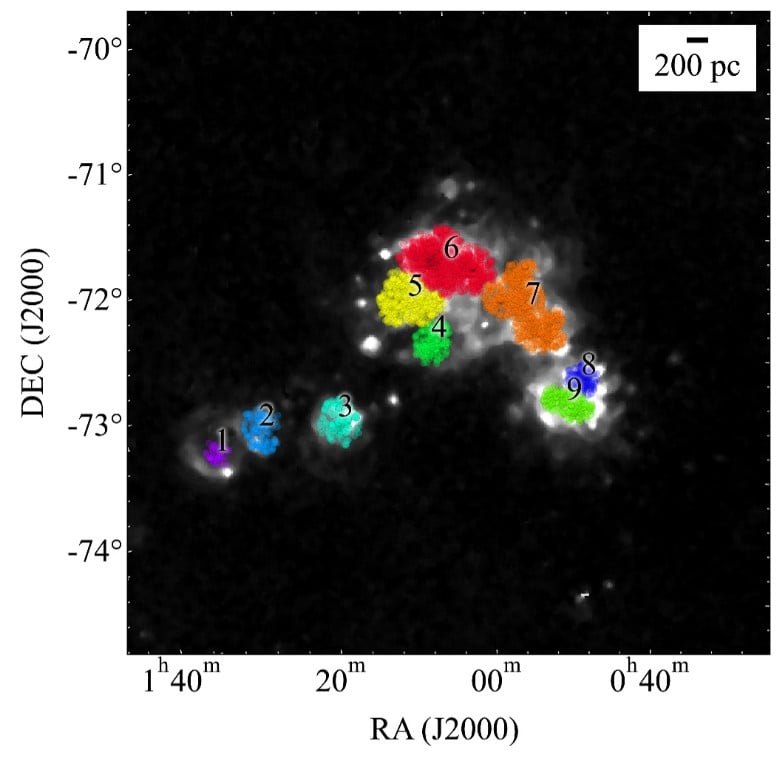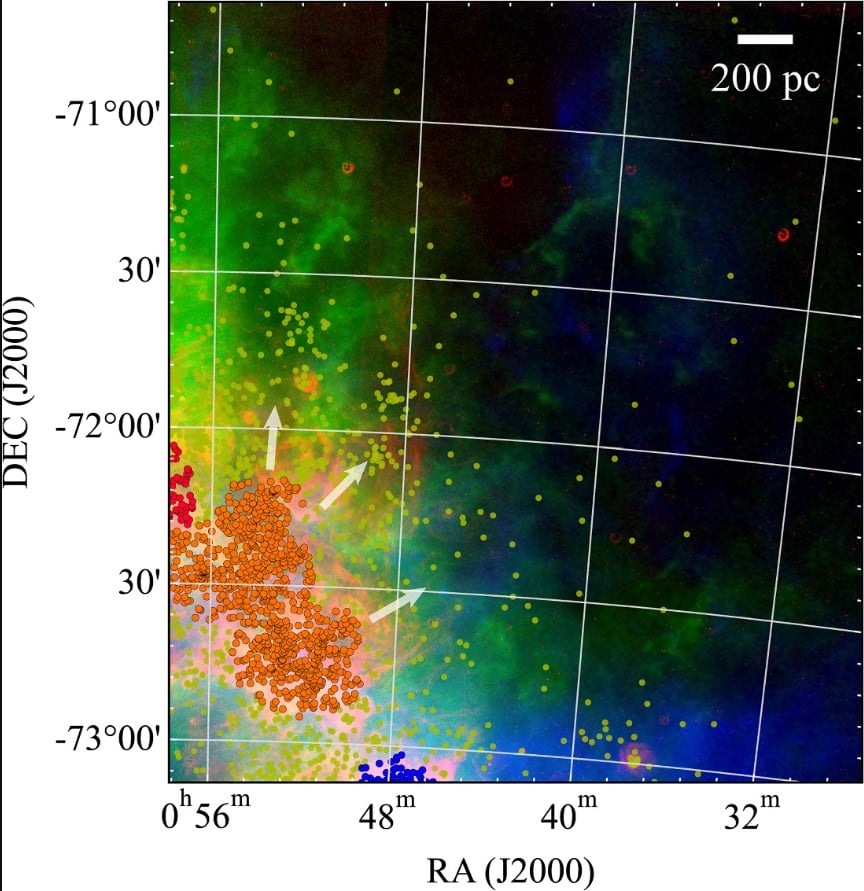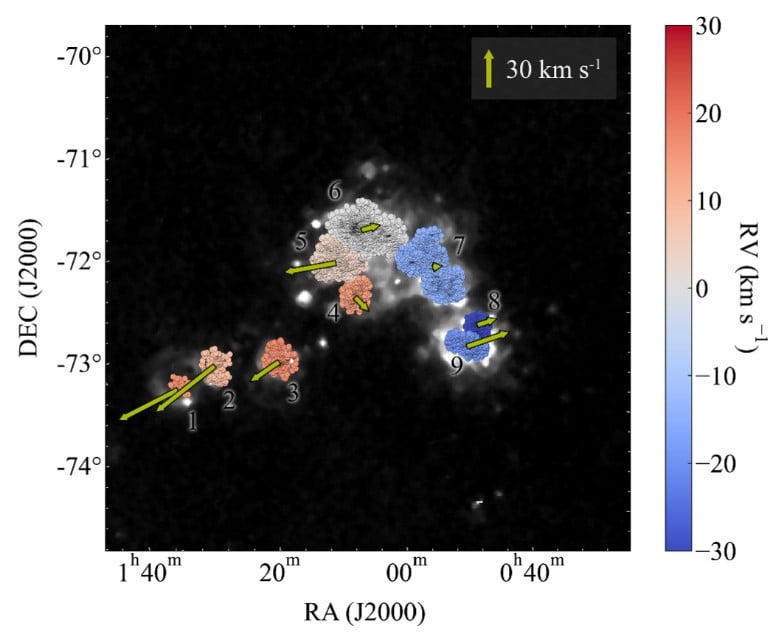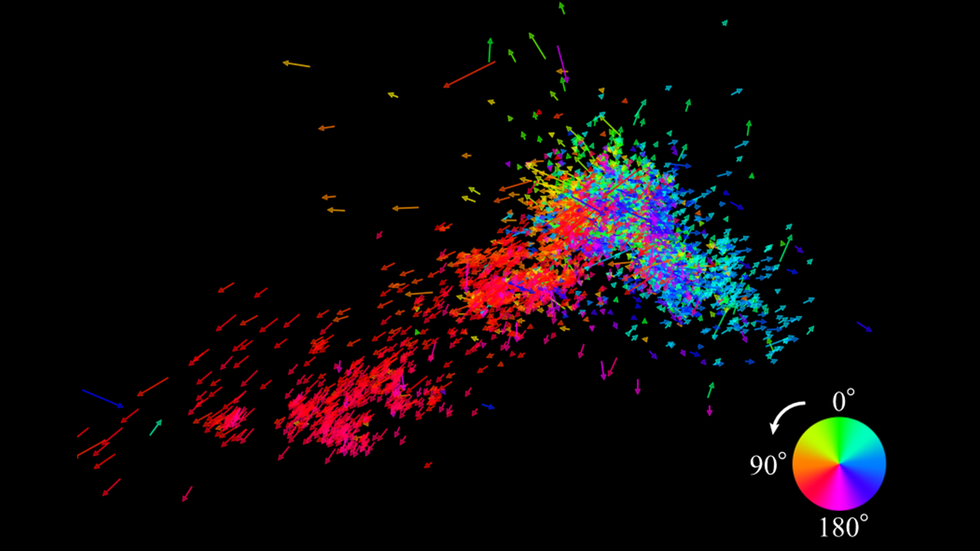The Small Magellanic Cloud is one of our closest galactic neighbours. It's a dwarf irregular galaxy about 200,000 light-years away, containing several hundred million stars. New research based on massive stars in the SMC shows it's being stretched along two different axes.
Thanks to the ESA's Gaia mission, we know the positions and velocities of a multitude of stars in the SMC. A team of researchers from Nagoya University in Japan used Gaia data to analyze more than 7,000 massive stars in the SMC to understand the kinematics of its stellar population.
The research, published in The Astrophysical Journal Letters, is titled "Evidence of Galactic Interaction in the Small Magellanic Cloud Probed by Gaia-selected Massive Star Candidates." The lead author is Satoya Nakano, a PhD student in the Department of Physics at Nagoya University.
The researchers examined 7,426 massive stars with more than eight solar masses to analyze the motions of stars in the SMC. These stars typically live short lives and explode as supernovae. Previous attempts to investigate the stellar motion were limited because it was difficult to determine their distances. However, a subset of these stars are Cepheid Variables, a reliable type of standard candle that allows astronomers to measure distances accurately.
 The panel on the left shows the Stellar density distribution around SMC obtained from Gaia data. The panel on the right shows the distribution of massive stars only, which are plotted with green circles. Image Credit: Nakano et al. 2025, ApJ Letters.
The panel on the left shows the Stellar density distribution around SMC obtained from Gaia data. The panel on the right shows the distribution of massive stars only, which are plotted with green circles. Image Credit: Nakano et al. 2025, ApJ Letters.
The researchers identified superstructures in the SMC, which they describe as "structures composed of massive stars on a scale of a few hundred parsecs." They're oriented on two axes they call the bar and the wing. They found six in the galactic bar and three in the wing.
 The nine numbered superstructures of massive stars in the SMC. Three are located on the axis that the researchers call the bar, and six are on the wing. Image Credit: Nakano et al. 2025, ApJ Letters.
The nine numbered superstructures of massive stars in the SMC. Three are located on the axis that the researchers call the bar, and six are on the wing. Image Credit: Nakano et al. 2025, ApJ Letters.
Researchers had previously discovered stars on the northwest-southeast axis. This research uncovered stars moving along a second axis from northeast to southwest. These complex stellar motions indicate that complex gravitational forces are pulling on the SMC. Its neighbour, the Large Magellanic Cloud, is responsible for some of it.
"When we first got this result, we suspected that there might be an error in our method of analysis," study co-author Kengo Tachihara said in a press release. "However, upon closer examination, the results are indisputable, and we were surprised."
The stars in the SMC were moving in opposite directions on either side of the galaxy, as though they are being pulled apart," Tachihara said. "Some of these stars are approaching the LMC, while others are moving away from it, suggesting the gravitational influence of the larger galaxy. This unexpected movement supports the hypothesis that the SMC is being disrupted by the LMC, leading to its gradual destruction.
 This image shows some of the massive stars in superstructure 7. The white arrows highlight the lines of massive star candidates extending from the superstructure. Image Credit: Nakano et al. 2025, ApJ Letters.
This image shows some of the massive stars in superstructure 7. The white arrows highlight the lines of massive star candidates extending from the superstructure. Image Credit: Nakano et al. 2025, ApJ Letters.
As an added observational bonus, these stars are so young that they haven't yet separated from the gas clouds that spawned them and are moving in unison with the SMC's hydrogen gas. In the Milky Way, the interstellar gas rotates with stars, but this work found something else. Since they detected no rotation in the SMC's young, massive stars, that means the gas isn't rotating either.
If the SMC is indeed not rotating, previous estimates of its mass and its interaction history with the Milky Way and LMC might need to be revised," Nakano explained. "This could potentially change our understanding of the history of the three-body interaction between the two Magellanic Clouds and the Milky Way.
The stars' proper motions point toward the SMC's outer regions; some move fast enough to escape. The superstructures show opposite proper motions and radial velocities and are moving away from one another. "This opposite motion is consistent with the influence of interactions with the LMC, which is located to the southwest, and can be explained by tidal forces and/or ram pressure, thereby rejecting the presence of galactic rotation in the SMC," the authors write. If astronomers have misidentified galactic rotation in the SMC, they may have it wrong in other, distant galaxies. This suggests that what appears to be rotation could be interference from a companion.
In previous work, the same researchers showed how the Large Magellanic Cloud is tugging on the Small Magellanic, illustrating that the two are bound together gravitationally. The relationship has influenced the structure and evolution of both small galaxies.
 This figure from the research letter shows the stars' proper motions and mean radial velocities for the massive stars in the nine superstructures. Image Credit: Nakano et al. 2025, ApJ Letters.
This figure from the research letter shows the stars' proper motions and mean radial velocities for the massive stars in the nine superstructures. Image Credit: Nakano et al. 2025, ApJ Letters.
However, the dual-axis nature of the stars in this research indicates more complexity.
"There is also a possibility that the gravitational influence from our own Milky Way or the effects from a past close encounter between the two Magellanic Clouds contribute to the stretching of the SMC," Tachihara said.
"Our discovery challenges previous theories of the galaxy's structure and dynamics. We need to rethink how the SMC, LMC, and the Milky Way interact. New simulations that consider the SMC's non-rotating nature are needed to understand these complex relationships," Nakano explained.
These observations can tell astronomers something about galaxies in general, not just our close neighbours. We can't get the same view of our galaxy or other, more distant neighbours as we can of the SMC and the LMC. The pair of galaxies could help us understand galaxy interactions, especially in the early Universe when they were likely more common.
The LMC and the SMC also share other characteristics with the early Universe, such as low metallicity. Metallicity can affect star formation, the properties of molecular clouds in which stars form, and even stellar feedback. Some of what the researchers are learning about the interactions between the SMC and the LMC may apply to the early Universe.
We are unable to get a 'bird's-eye view' of the galaxy in which we live," Tachihara said. "As a result, the SMC and the LMC are the only galaxies in which we can observe the details of stellar motion. This research is important because it allows us to study the process of star formation in connection with the motion of stars throughout the galaxy.
Press Release:Research suggests our closest neighboring galaxy may be being torn apart
 Universe Today
Universe Today
